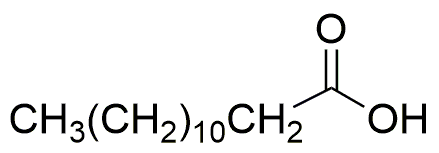Tridecanoic acid is widely utilized in research focused on:
- Food Industry: It serves as a flavoring agent and emulsifier in various food products, enhancing taste and texture.
- Cosmetics and Personal Care: This compound is used in formulating creams and lotions due to its moisturizing properties, making skin feel softer and smoother.
- Biodegradable Plastics: Tridecanoic acid is incorporated into the production of biodegradable polymers, contributing to environmentally friendly packaging solutions.
- Pharmaceuticals: It acts as a building block in the synthesis of certain drugs, improving their efficacy and stability.
- Industrial Lubricants: The chemical is used in formulating high-performance lubricants that reduce friction and wear in machinery, enhancing operational efficiency.
General Information
Properties
Safety and Regulations
Applications
Tridecanoic acid is widely utilized in research focused on:
- Food Industry: It serves as a flavoring agent and emulsifier in various food products, enhancing taste and texture.
- Cosmetics and Personal Care: This compound is used in formulating creams and lotions due to its moisturizing properties, making skin feel softer and smoother.
- Biodegradable Plastics: Tridecanoic acid is incorporated into the production of biodegradable polymers, contributing to environmentally friendly packaging solutions.
- Pharmaceuticals: It acts as a building block in the synthesis of certain drugs, improving their efficacy and stability.
- Industrial Lubricants: The chemical is used in formulating high-performance lubricants that reduce friction and wear in machinery, enhancing operational efficiency.
Documents
Safety Data Sheets (SDS)
The SDS provides comprehensive safety information on handling, storage, and disposal of the product.
Product Specification (PS)
The PS provides a comprehensive breakdown of the product’s properties, including chemical composition, physical state, purity, and storage requirements. It also details acceptable quality ranges and the product's intended applications.
Certificates of Analysis (COA)
Search for Certificates of Analysis (COA) by entering the products Lot Number. Lot and Batch Numbers can be found on a product’s label following the words ‘Lot’ or ‘Batch’.
*Catalog Number
*Lot Number
Certificates Of Origin (COO)
This COO confirms the country where the product was manufactured, and also details the materials and components used in it and whether it is derived from natural, synthetic, or other specific sources. This certificate may be required for customs, trade, and regulatory compliance.
*Catalog Number
*Lot Number
Safety Data Sheets (SDS)
The SDS provides comprehensive safety information on handling, storage, and disposal of the product.
DownloadProduct Specification (PS)
The PS provides a comprehensive breakdown of the product’s properties, including chemical composition, physical state, purity, and storage requirements. It also details acceptable quality ranges and the product's intended applications.
DownloadCertificates of Analysis (COA)
Search for Certificates of Analysis (COA) by entering the products Lot Number. Lot and Batch Numbers can be found on a product’s label following the words ‘Lot’ or ‘Batch’.
*Catalog Number
*Lot Number
Certificates Of Origin (COO)
This COO confirms the country where the product was manufactured, and also details the materials and components used in it and whether it is derived from natural, synthetic, or other specific sources. This certificate may be required for customs, trade, and regulatory compliance.

